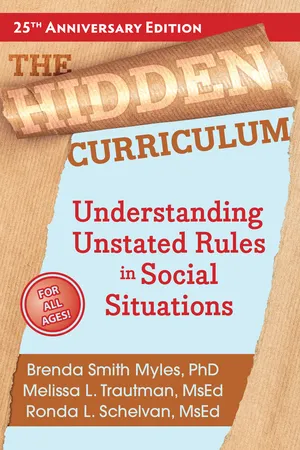
The Hidden Curriculum
Understanding Unstated Rules in Social Situations
- English
- ePUB (mobile friendly)
- Available on iOS & Android
The Hidden Curriculum
Understanding Unstated Rules in Social Situations
About this book
Shred through Social Confusion!
The world around us is a complicated place filled with expectations, rules, assumptions, guidelines, regulations, and policies. This "hidden curriculum" exists across environments, places, people, and cultures. Although rules and mandates can be complex, most of us take comfort in them—often unconsciously—because they help us to know what to do in everyday situations. We like rules if they are consistent. It is when they are unclear, or are unstated that we can become upset, indignant, or confused. Some people learn the hidden curriculum and its impact automatically. Others learn the hidden curriculum only by direct instruction. That is the purpose of this book.
In this third edition, the essential features of the original book have been maintained and information on evidence-based practices has been added. In addition, it provides a series of instructional strategies that can be used to teach the hidden curriculum. Instructional aids include charts, forms, and templates designed to make the job of teaching and learning the hidden curriculum more effective.
Finally, The Hidden Curriculum offers extensive lists of hidden curriculum items or unstated guidelines. Due to the elusive nature of the hidden curriculum, the lists—while broad—offer examples rather than a definite set of lessons to be learned. Parents, educators, support persons, and others are encouraged to consider the lists as springboards to make their own lists geared specifically toward the unique needs of the individuals with whom they work or live.
Frequently asked questions
- Essential is ideal for learners and professionals who enjoy exploring a wide range of subjects. Access the Essential Library with 800,000+ trusted titles and best-sellers across business, personal growth, and the humanities. Includes unlimited reading time and Standard Read Aloud voice.
- Complete: Perfect for advanced learners and researchers needing full, unrestricted access. Unlock 1.4M+ books across hundreds of subjects, including academic and specialized titles. The Complete Plan also includes advanced features like Premium Read Aloud and Research Assistant.
Please note we cannot support devices running on iOS 13 and Android 7 or earlier. Learn more about using the app.
Information
Table of contents
- Peter Gerhardt (personal communication, April 2004) talks about the hidden curriculum of urinals. For example, if there is only one man at a urinal, the hidden curriculum dictates that a newcomer should not go to the urinal next to that person. Rather, they should go to a urinal that is at least two stalls away. Also, boys and young men should know that they are not to talk to someone while they are at the urinal and that they should never go to the bathroom in groups. Further, boys and young men should merely unzip to urinate rather than pulling down their pants at the urinal. Boys who pull down their pants could be open to victimization or be accused of exhibitionism.
- The hidden curriculum also includes idioms, metaphors, multiple-meaning words, and slang—things most people “just pick up” or learn through observation or subtle cues, including body language. For example, to most a term such as “get off my back” and accompanying body language (frowning, looking irritated, raising voice) communicates that the speaker wants to be left alone, but to somebody who does not automatically pick up information from their environment or predominantly interprets language literally due to neurological differences, the term will have a totally different meaning and be very confusing. Understanding the hidden curriculum can make a huge difference in the lives of autistic people—it can keep them out of trouble and help them make friends.
- While some of the examples in this book may seem somewhat humorous, the impact of not knowing or following the hidden curriculum can be serious. A demonstration of not understanding the hidden curriculum can cause an individual to be bullied, ignored, made fun of, or misunderstood. Its impact can be felt in school, community, or home, on the job, or in the judicial system as described below. Equally important to understanding the hidden curriculum across environments, it is also essential individuals understand themselves and their own hidden curriculum.
- Teachers who are in negative relationships with learners tend to feel frustrated, irritable, and angry. They often engage in educational bullying. Educational bullying occurs when adults who are members of the school staff use their power intentionally or unintentionally to cause students distress. Educators who bully tend to yell, make snide or sarcastic comments, and use harsh punitive control to manage behavior (Gusfre, Stoon, & Fandrem, 2022). These teachers often describe themselves as “struggling” or “in constant conflict” and describe students as “exhausting” or “leaving them feeling drained and burned out” (Rimm-Kaufman et al., 2002). Students in the classroom of such teachers not only fail to reap the benefits of academic and social improvement, they are also rejected, victimized, and bullied by classmates who model the inappropriate behavior of the teacher (Gusfre et al., 2022).
- Readers need to keep in mind that the hidden curriculum items presented here are general guidelines of what to do or what not to do. As discussed earlier, they may differ based on whom you are with, where you are, the interpretation or perspective of those involved, and so on. On each page of the Hidden Curriculum Items, the words context and prediction appear. This is a reminder to instructors to incorporate these concepts. Please see pages 39–40 for a brief review of context and prediction. It is always a good idea for those learning the hidden curriculum to discuss these items with adults they trust. The hidden curriculum items are organized around the following major topics: